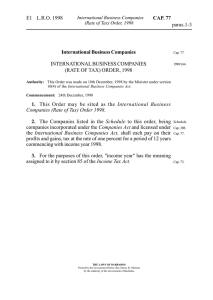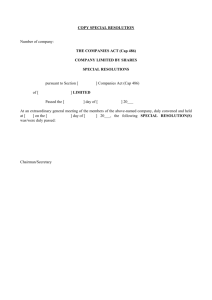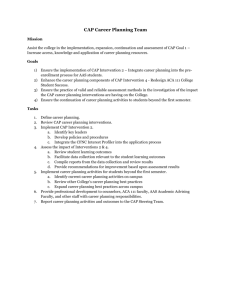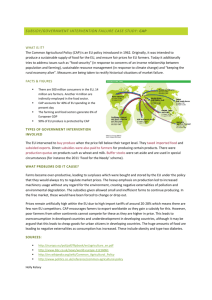Life newsletter BALL STATE UNIVERSITY | COLLEGE OF ARCHITECTURE AND PLANNING
advertisement
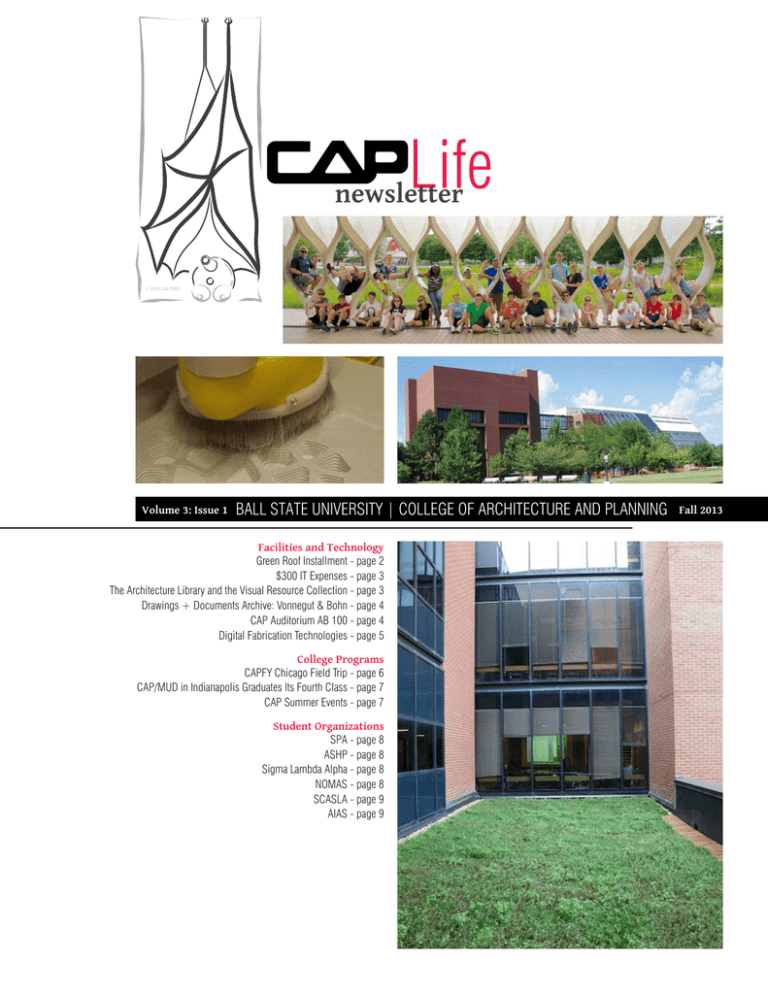
Life newsletter c 2013 CAP/BSU Volume 3: Issue 1 BALL STATE UNIVERSITY | COLLEGE OF ARCHITECTURE AND PLANNING Facilities and Technology Green Roof Installment - page 2 $300 IT Expenses - page 3 The Architecture Library and the Visual Resource Collection - page 3 Drawings + Documents Archive: Vonnegut & Bohn - page 4 CAP Auditorium AB 100 - page 4 Digital Fabrication Technologies - page 5 College Programs CAPFY Chicago Field Trip - page 6 CAP/MUD in Indianapolis Graduates Its Fourth Class - page 7 CAP Summer Events - page 7 Student Organizations SPA - page 8 ASHP - page 8 Sigma Lambda Alpha - page 8 NOMAS - page 8 SCASLA - page 9 AIAS - page 9 Fall 2013 Life newsletter Facilities & Technology Green Roof Installment Contents Check it out! We now have a green roof located over the CNC Lab (seen from the third floor). This project is the second green roof on Ball State University’s campus, however, the first as part of an academic building. This living roof is a step forward in accomplishing the university’s goal of a vibrant and sustainable campus. Professors German Cruz and Michel Mounayar lead CAP’s effort for the design and installation of this living design exhibit in support of our academic mission. Roger Whitted, and Design Build Lab graduate assistant Andrew Brindley were instrumental in the construction and installation of the roof and its detail finish. The university’s office of Facilities Planning assisted CAP with the structural engineering and the addition of an irrigation system. The system was installed with the assistance of the company LiveRoof, several students and faculty this summer. The roof is comprised of a series of interlocking crates that contain a special mix of sedum that will produce a beautiful blanket of color and interest throughout the year. This roof system will help retain runoff water and reduce the need for storm drainage. The DBL assisted in the crafting and installation of special stone and cedar perimeter finishing the roof for students to enjoy and study. So far everything is working great with the installation, and the vegetation having acclimated to this new setting. The stone and wood perimeter is allowing excess rainfall to drain perfectly! The green roof will serve the college as an excellent display and teaching tool. Now that it has been installed, students can see an active green roof up-close and personal. Faculty and staff can now show students how green roofs may play a role in design and be an effective tool in storm-water management. This was in no part a simple project for the college, and we would like to thank everyone who participated in making this possible: our most gracious thanks to German Cruz, who supplied the design, Malcolm Cairns, Les Smith, Harry Eggink, Greg Graham, Joyce Jones-Myers, and Roger Whitted and many more for their efforts and contribution in coordination and accomplishment of this wonderful new CAP asset. Photos by Chris Helms Life newsletter Facilities & Technology $300 IT Expenses Contents This CAP program is a wonderful support for digital needs for teaching, research, and service. Each full-time faculty member within CAP will receive $300 for IT support this year. Faculty members are allowed to contribute personal funds to the $300, however the purchase cost must be under $500 total and purchased items will be owned and property of Ball State University. Should a faculty member decide to leave the University, the purchased items must be returned, even if the purchase include a personal contribution, as it is the case for any other Ball State University property. Also as Ball State University is a not-for-profit entity, the College will not reimburse sales tax. It is best to consult with Melanie Smith in the dean’s office prior to initiating a sale. Reimbursements must also be submitted to Melanie no later than April 30th, 2014. Mobile phone devices or any technology that uses cellular digital access will not be supported by these funds. Examples of allowable expenses include: WIFI Ipads, digital cameras, flash drives, remote controls, etc. Please also note the University is moving away from ink jet printers - ink jet printers will not be reimbursed with these funds. The Architecture Library and the Visual Resources Collection Contents September is for Research in the Architecture Library and the Visual Resources Collection Each month we highlight a different theme in the library and in September the focus was on research. September is a busy month in the Architecture Library (AB 116) and a crucial time in the semester as students begin work on long-term assignments, start to map out their theses and creative projects, and delve into course reserve readings. The library offers a variety of resources to support student research projects and throughout the month we highlighted the databases and discovery tools that help you find these resources. We also featured time-saving library services, such as on-shelf holds and online renewals, and timely assistance in the form of reference appointments with the librarian, workshops, and the library subject guides. In addition to databases and published resources in the library, your research might take you to the Visual Resources Collection (VRC) in AB 117, which is home to the Building Material Samples Collection and the Architecture Images Collection. The samples of innovative or sustainable materials in the collection can all be checked out for four days, and the architecture, landscape architecture, urban planning, and historic preservation images in the Architecture Images Collection are available online in the University Libraries Digital Media Repository: http://libx.bsu.edu/. Research was the library’s theme of the month for September, but keep in mind that we’re here to assist you with your research all year long! Amy Trendler, Architecture Librarian Life newsletter Facilities & Technology Drawings + Documents Archive: Vonnegut & Bohn Contents The Drawings + Documents Archive’s collection of drawings and photographs from the prominent Indianapolis architectural firm of Vonnegut & Bohn is now available online in the Ball State University Libraries’ Digital Media Repository. Materials include photographs and architectural drawings for 16 building projects in Indianapolis and Evansville, Indiana. The collection is part of the larger Wright, Porteous, and Lowe Architectural Records, and is the first series of the collection to be digitized. Plans include drawings for Indianapolis Public School #33, Kahn Tailoring Company, Merchants Building, Evansville Telephone Exchange Building, The Children’s Museum addition, a gas station, and the Vonnegut Hardware Store. Photographs depict the Atheneum, Herron School of Art, Roosevelt Building, Lyric Theater, and the daring move of the Indiana Bell Telephone Company Building. http://libx.bsu.edu Carol Street, Archivist for Architectural Records CAP Auditorium AB 100 Thanks to strong support from BSU IT the technology for room 100 has been upgraded! Improvements include a new high-resolution projection system with Blu-ray capabilities. The system includes a new touch-based interface and Apple TV system so those presenting now have the ability to run the projector from their personal I-pad. The screen has been improved and the center channel image size is considerably larger. Please come visit during a lecture to check-out our new technology in action! For those interested in using the Apple TV system, please contact Chris Helms. Contents Life newsletter Facilities & Technology Digital Fabrication Technologies Contents As digital fabrication technologies have become an integral part of the design curriculum and profession, CAP provides students with access to a 3D printer and CNC mill. With the exclusion of first year students, all others have access to the Z-Corp solid object color 3D printer and the 3 axis Thermwood CNC mill. In order to correctly use both machines, please review the information below: Z-Corp Solid Object Printer •Print cost is based on the amount of material used. A free estimate can be given prior to printing with no obligation. All prints are billed directly to the Bursar Office. Note that the staff and GA’s will not collect any form of payment, nor can they adjudicate these bills between students and the Bursar’s office. •The maximum print size is 8” L x 10” W x 8” H •Color printing is possible at no added cost. Simply apply a color to a material in Rhino, this is not the same as layer color. Material is a separate column next to the layer column and has a small circle in each row. •It is recommended that no part be narrower in diameter or thinner in width than 1/8” for stability. The printer can print smaller, but keep in mind parts might break if adequate support is not provided. Thermwood CNC Mill •There is no Bursar charge for using the CNC mill. It is a free service for CAP students just like the laser cutters and woodshop tools. •Think of the object to be printed as needing to hold water. If there are holes in a surface, your print may not work properly. Adjust tolerances in Rhino to at least .001” and refer to the McNeel & Associates website for troubleshooting mesh problems. •Schedule a milling appointment at least 3 days prior to your requested date. Once a time is scheduled, a meeting will take place where the GA will look over your file and create the necessary code for the machine. •Please bring your Rhino file to the printer at your scheduled time. If using Rhino 5, down save to Rhino 4 for use on the printer’s computer. Please be on time, showing up late will delay others and could result in your print being started at a later time. •The Thermwood can cut through a variety of materials. Most common are: hardwoods, MDF, foam, acrylic, and plywood. Other materials can be cut with approval. No metals may be cut at any time. •When the print is completed you will need to excavate it from the machine. Please be on time for excavation. Promptly excavating your print ensures that other students can remove their own projects. If you are not on time, the GA will excavate your print for you with the understanding that they are not responsible for any damage incurred. •Do not cut the material down to the exact size prior to milling; the machine can do this for you. •Maximum bed size is 10’x5’ •Please show up to your scheduled time with your material. It is suggested to bring extra material as well. Material testing is often required. •Closed toe shoes are required. Safety glasses and ear protection are provided in the CNC room and must be worn when the machine is in operation. If you are interested in using or learning more about either piece of equipment, please contact one of the GA’s at the following email address. Class demonstrations can also be made through the same email address. All appointments are made on a first-come first-serve basis in the order in which the emails are received: Daniel Potash and Robert Cichocki bsucnc@gmail.com Daniel Potash & Rob Cichocki Photos by Daniel Potash College Programs Life newsletter CAPFY Chicago Field Trip The CAP first year field trip to Chicago conducted in the summer semester of 2013 allowed students of the CAPFY spring admission class to explore a range of issues applicable to the disciplines of urban planning, landscape architecture, and architecture. Students had a full itinerary that included walking tours of the University of Chicago campus buildings and courtyards, including examples by Raphael Vinoly, Bertram Goodhue, and Frank Lloyd Wright. The tour ventured on to the Illinois Institute of Technology campus, with visits to Crown Hall by Mies van der Rohe, and the McCormick Tribune Campus Center by OMA / Rem Koolhaas. We took in several open spaces in the Chicago downtown loop, including visits to the Chicago Vietnam Memorial (Ross Barney and Jankowski), Chicago Model City exhibit, a current exhibit on future designs for the city, and a Wendella Architecture river boat tour. Extensive study of Milennium Park influenced and informed their studio assignments back in Muncie. Students experienced early transit oriented development with a walking tour of Oak Park, a neighborhood that has a history of progressive social diversity as well as sites relevant to Frank Lloyd Wright, a guided tour of Unity Temple, a walking tour of the Lincoln Park historic neighborhood (with several blocks that survived the Chicago fire), and a day at the Chicago Botanic Garden of Glencoe, Illinois, including landscapes by Dan Kiley, Ohme van Sweden, and others, as well as buildings by Edward Larabee Barnes, and the recent Rice Center for Plant Science Studies by Booth Hansen (rated LEED gold). Lohren Ray Deeg, ASAI, Assistant Professor of Urban Planning Simon Bussiere, ASLA, Assistant Professor of Landscape Architecture Photos by Chris Helms Life newsletter College Programs CAP/MUD in Indianapolis Graduates Its Fourth Class Contents Summer commencement marked the official celebration of the course completion and graduation of CAP’s fourth Indianapolis-based Master of Urban Design cohort, with seven strong completed degree requirements. MUD is another of CAP’s multidisciplinary programs that attracts, architects, landscape architects, civil engineers, and urban planners from the U.S. and abroad. The studios are currently located in the Ball State Indianapolis Center located on Meridian Street, just two blocks south of the circle. This year we had much to celebrate, especially the notable success of one of our student teams, led by professor Bruce Race, nominated to the prestigious and select group of finalists for the 2013 ULI design competition. The team was awarded $10,000.00 dollars and travelled to Minneapolis Minnesota to present their designs and development ideas in front of a distinguished panel of developers and designers. The class also spun a new urban design format entitled the “briefing” where students unveiled and explained their work to the design community at large. Students’ proposals included research and redesign concepts for downtown Indianapolis districts and neighborhoods that are currently overtaken by surface parking and the automobile. These projects are also published in a design booklet summarizing each student’s proposal and design. One additional tradition was born this summer, initiated by MUD alumni, who extended their invitation to both past and present students and faculty to meet on annual basis for a real urban picnic. MUD alumni reached out through an open invitation to colleagues and current students to join for an afternoon of fun and fellowship. Consequently, the first MUD Annual Picnic was held September 8th 2013 in Canterbury Park, Indianapolis. The new students enjoyed meeting and sharing the evergrowing legends of the program. M. Mounayar, Photos by Bruce Race & M. Mounayar CAP Summer Events Summer Scholars – Minority based recruitment program for high school students operated through the Office of Admissions. These groups met on June 10, 12, 17, 19, 24, 26, July 8 and 10 and 1 p.m. in studio. The CAP Ambassadors, Chandra Aylsworth, Chloe’ Dotson, Lindsay Heuvelman, Lynne Mirabella, and Brittany Harvey split the group into teams. The teams were to develop and design a small city that included all aspects of the CAP professions. Each group consisted of approximately 15-20 students. Students were given information about the CAP to take with them. Cardinal Kids Camp (CKC) – June 10 – The CAP had the opportunity to be incorporated into a session of the Cardinal Kids Camp. CKC is held each year throughout the summer, consisting of mostly area children coming to campus to have fun at camp. This year CKC incorporated a component to showcase different departments around Ball State. There were 110 kids who participated. The kids were split into two groups consisting of kindergarten through fourth grade and Contents fifth grade through eighth grade. The K-4 group made towers out of wooden sticks and fruit snacks. They also drew housing structures. These students also presented their towers to the entire class. The 5-8th graders were asked to choose a word that described them and to develop a mask. At the end of the class, they were to tell them group about their mask and their word. Again, CAP Ambassadors assisted with working with the groups and informing the students about professionals in the CAP. Each upper-level student left with materials about the CAP. Lowergrade students left with a sheet describing the three professions; landscape architecture, urban planning, and architecture. Project Stepping Stone – Approximately 30 high-ability Latino high school students visited the CAP on June 19 to tour the CAP facilities; arranged through the Office of Admissions. They made stops in the Library, Archives, the Fab lab, Sim lab, CRC, and studio. Each student received a folder containing information about each department and the admission process at the CAP. Their tour guides were CAP Ambassadors Lynne Mirabella and Lindsay Heuvelman. State Fair – August 2 – Zach Lutz, Jon Hunsberger, Leigh Seibert, Bethanie Martin, Chris Helms, and Brad Beaubien helped patrons build towers out of straws and marshmallows and also took photos at a photo booth themed to reflect all three CAP disciplines. Students used the opportunity to express what their profession is all about. Also, through the two-week state fair a variety of boards, models, projects, and technology was on display at the CAP booth. Lori Pence student organizations Life newsletter Contents SPA The new executive board for the Student Planning Association (SPA) has been working to make this a great and eventful year for its members. SPA will have its first general meeting on September 25th, and several events and activities are soon to follow. SPAs first organized event will be to take a group of students to volunteer at Noblesville’s Box City. This event teaching kids about the basics of planning and cities will span three days from the 7th to the 9th of October. SPA will then have its second general meeting on the 9th with a guest speaker from the DWNTWN group. Setup for the Indiana APA conference here at Ball State will then take place. On October 10th and 11th students will have the chance to participate in the Indiana APA Conference here on campus. Activities will include meeting the urban planning Class of 1968, the pioneer class of our department, having their work displayed during the conference, and giving short presentations over some past or current projects. Other projects SPA plans to take part in include Downtown Cleanups, volunteering with Habitat for Humanity, and visiting the People for Urban Progress facilities. Alongside those activities SPA will be promoting and organizing two programs. The first is a mentorship program that will pair up each interested student with an active practitioner who will serve as a mentor through out the rest of their time here in school and as students start their careers. The second will be a program that was started by Vera Adams last year. This program, called Just Lunch will, pair up students with active planners around the state for the students to simply connect with by touring their office and having lunch. SPA also plans to team up with other organizations throughout the year for special events and activities. To conclude, we have a lot of great events and opportunities that are coming up and that we hope the students are able to enjoy and take advantage of. Sigma Lambda Alpha This fall Sigma Lambda Alpha, the scholastic honorary society for the profession of Landscape Architecture, hopes to bring more to the table for its scholarly members. At our first meeting members were elected to officer positions and possible events were planned for the future. Kyle Koger serves as our treasurer, Cassie Wells serves as secretary, Kourtney Dillavou serves as our Vice President, and Hannah Lintner serves as SLA President. Right now our chapter is small in number but we hope to grow this fall. Currently we have 39 potential inductees. We are in the process of hand delivering invitations and waiting to hear replies. Inductions will take place late October, early November with an etiquette dinner to follow, welcoming our new members. Thus far we have helped raise awareness for the White River Cleanup and hope to provide guest speakers in the future once our new members have joined. NOMAS NOMAS, the National Organization of Minority Architecture Students, is the student branch off of the national organization, NOMA. We are comprised of people from all majors in the CAP building and pretty much all academic levels. We even have a member who is journalism major. Some of our events include attending the NOMA conference and student design competition, participating in community service, visiting firms, discussing the glory and hardships of minority designers, and our famous donut shop, which will start after field trip week. We welcome anyone from any major, any academic level, and any walk of life! We meet on Mondays following studio at 5pm in room AB310. OCTOBER 16-18 Photos must be 8x10 and submitted Oct. Mon.-Tues. Oct 14 & 15 to the ASHP collection group in the atrium. ASHP The Associated Students for Historic Preservation are holding a photography contest again this year October 16-18. Photos must be 8x10 and are due by noon Tuesday October 15. More information will be posted soon! Also, we are excited to announce that the National Trust for Historic Preservation’s Annual Conference is in Indianapolis this year. We invite everyone interested in historic preservation to join. We will be carpooling for anyone interested. Visit www. preservationnation.org/resources/training/npc/ For more information, contact Kathi Corwin at kecorwin@bsu.edu TO O H P A ST E T N S CO H P All entries are $1 CATEGORIES INCLUDE: ated Associ ts for Studen Architecture Landscape Interior Animal People Digitally Altered/Instagram Candid Studio Moments c ri Histo Preser RULES: All photos must be original photos. No digital altering is allowed except for the “Digital Altered/ Instagram” category. Please, no drugs, nudity, nor dead bodies. ASHP and CAP reserve the right to refuse photos. Ball State University’s ASHP © 2013 vation Voting will take place Wed. October 16 - Fri. Oct 18 in the CAP Atrium from 10am-2pm. Points are as Follows: 1cent =1pt. There will be a bonus for paper money voting! Photos must be originals! For more information, please contact Kathi Corwin at: kecorwin@bsu.edu student organizations Life newsletter Contents SCASLA The SCASLA has been hard at work planning events, workshops, and biweekly meetings for LA students and current members. With a new constitution in place, ASLA is redefining itself on many levels. Through connections with faculty, INASLA and potentially other SCASLA chapters, we are excited to provide additional networking opportunities for members. Fall 2013 SCASLA Events: • Park(ing) Day: a demonstration on campus involving the 12 hour use of 3 metered parking spots as urban parks. AIAS AIAS has several events planned for the fall semester. Eight students just got back from networking with professionals for three days at the AIA Ohio Valley Convention in Louisville, Kentucky. The students were sponsored by AIA Indiana and several local firms, making the trip affordable. We are partnering with YAF Indy and the FAIA of Indy for a tour of the Miller House in Columbus, In., on Oct. 5th. AIAS Ball State is also hosting the AIAS Midwest Quad Conference for 200 students from schools throughout the region. The conference is Oct. 25-27 and will take place in Columbus, In., with a focus on the “Icons” of the city. • INASLA Annual Meeting: the opportunity for SCASLA members to volunteer and attend workshops and presentations at the annual meeting in Carmel, Indiana. • Living Lightly Fair: our second year hosting a booth at the Living Lightly fair to promote use of native plants and showcase the profession of landscape architecture. • SCASLA Workshop Series: hour long faculty led workshops on a variety of design skills and topics. o Digital Footprinting with Simon Bussiere o Color Rendering with German Cruz o Section Graphics with Miran Day • 3 Part Internship Preparation Workshop o Internship Panel Discussion o Portfolio and Resume Review with Faculty o Mock Interview with Guest Practitioners (October 23) • Applefest: this revamped event will include tournament style field games, free food, and networking opportunities. Bolded events will be open to all practitioners interested in attending. SCASLA meets on a bi-weekly basis. Look for additional information and announcements via e-mail, the website (http:// bsuasla.wix.com/bsuasla), and the yellow bulletin board in the second floor atrium. If you have any questions or concerns, please e-mail us at asla@bsu.edu College of Architecture and Planning Architecture Building (AB), Room 104 Ball State University Muncie, IN 47306 Phone: 765-285-5859 Fax: 765-285-3726 Email: cap@bsu.edu
